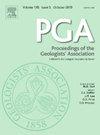Discovery of a phosphatic helical-looking microstructure in Sphenothallus (Cnidaria) from the Late Ordovician of Estonia: Implications for phosphatic biomineralization
IF 1.3
4区 地球科学
Q2 Earth and Planetary Sciences
引用次数: 0
Abstract
The tube of Sphenothallus cf. longissimus from the Late Ordovician of Estonia features a phosphatic, broadly laminar structure. It consists of four to five major laminae; each of the laminae is homogenous exteriorly and shows remains of fibres at the bottom. The fibres in most external tube parts exhibit a plywood structure akin to that of Carboniferous Sphenothallus specimens from Russia, whilst the microstructure of a fibrous lamella in the internal part of the tube resembles the aragonitic helical structure found in molluscs. The reinterpretation of the plywood structure as an original biomineral structure of Sphenothallus and the discovery of a phosphatic structure resembling the aragonitic helical structure of molluscs suggest that the biomineralization capabilities of Sphenothallus may have been exceptional among Cnidaria. It now appears possible that phosphatic biomineralization was significantly more advanced than carbonate biomineralization within Cnidaria. This enhanced phosphatic biomineralization could have provided Sphenothallus with evolutionary advantages over similar encrusting tubicolous organisms with less developed biomineralization during the Paleozoic era.
在爱沙尼亚晚奥陶世Sphenothallus(刺胞属)中发现的一个磷化螺旋状微观结构:磷化生物矿化的意义
来自爱沙尼亚晚奥陶世的Sphenothallus cff . longissimus的管状结构具有磷化的宽层流结构。它由4 - 5个主要的纹层组成;每一层表面都是均匀的,底部有纤维的残余。大多数试管外部部分的纤维呈现胶合板结构,类似于来自俄罗斯石炭纪蝶形标本的纤维结构,而试管内部纤维薄片的微观结构类似于软体动物中发现的文石螺旋结构。将胶合板结构重新解释为Sphenothallus的原始生物矿物结构,并发现类似软体动物文石螺旋结构的磷酸盐结构,这表明Sphenothallus的生物矿化能力可能在刺胞动物中是例外的。现在看来,在刺胞菌中,磷酸盐生物矿化可能比碳酸盐生物矿化要先进得多。与古生代生物矿化程度较低的类似壳状管状生物相比,这种增强的磷生物矿化作用可能为蝶藻提供了进化优势。
本文章由计算机程序翻译,如有差异,请以英文原文为准。
求助全文
约1分钟内获得全文
求助全文
来源期刊
CiteScore
2.70
自引率
8.30%
发文量
54
审稿时长
6-12 weeks
期刊介绍:
The Proceedings of the Geologists'' Association is an international geoscience journal that was founded in 1859 and publishes research and review papers on all aspects of Earth Science. In particular, papers will focus on the geology of northwestern Europe and the Mediterranean, including both the onshore and offshore record. Following a long tradition, the PGA will focus on: i) a range of article types (see below) on topics of wide relevance to Earth Sciences ii) papers on aspects of Earth Science that have societal relevance including geoconservation and Earth management, iii) papers on palaeoenvironments and palaeontology of the Mesozoic and Cenozoic, iv) papers on aspects of Quaternary geology and climate change, and v) papers on the history of geology with particular reference to individuals that have shaped the subject. These topics will also steer the content of the themes of the Special Issues that are published in the PGA.

 求助内容:
求助内容: 应助结果提醒方式:
应助结果提醒方式:


